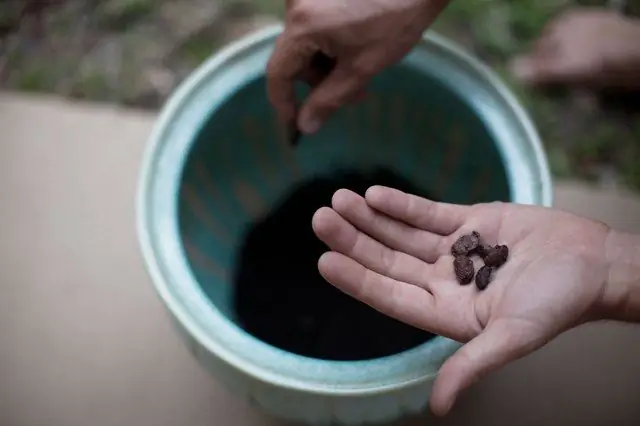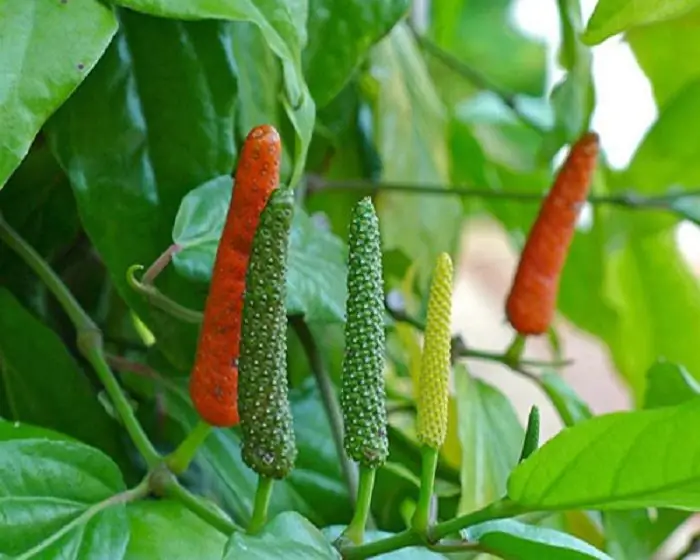2026 Author: Howard Calhoun | [email protected]. Last modified: 2025-01-24 13:10:34
Mustard is a vegetable crop belonging to the Cruciferous family. There are several dozen species of this plant, but only three varieties are used as spices - white, black and brown.
White Mustard (Latin Sinapsis alba) is common in North America and Europe. The plant is annual, low (60 cm). Mustard seeds of this variety are very light, with a touch of honey, moderately pungent.

Brown mustard (or sarepta, lat. Brassica juncea, eng. Brown Mustard) is ahead of both white and black in popularity. Moderately spicy. Mustard seeds - 2 mm in diameter, rounded, brown or brown. The Himalayas are considered the birthplace of the plant, although it is cultivated mainly in India. Russia "met" brown mustard in the 18th century. thanks to the Germans invited by Catherine II to the development of the south of Russia. Among the first settlers was a missionary,doctor and translator Konrad Neitz. It was with his "light hand" mustard got on the royal table.
Brown mustard is now sold in powder form and as a regular table in almost every grocery store.

Black mustard (Black Mustard, lat. Brassica nigra), also called French, has a rather long stem, up to a meter. Seed pods open immediately after ripening, making harvesting extremely difficult. It is grown mainly in South Asia. Black mustard seeds are the most pungent, but also the most aromatic, of the cultivated varieties.

This plant has been valued since antiquity both as a medicinal and as a culinary one. The unique properties of mustard are due to the substances it contains, incl. minerals (calcium, copper, manganese, selenium, iron, zinc), phytohormones, vitamins, antioxidants. Mustard seeds are a real storehouse of energy and dietary fiber, which is very important for those who suffer from excess cholesterol, which is fought by niacin (vitamin B3). The fruits contain flavonoids (antioxidants), lutein, zeaxanthin, carotene and many vitamins that fight free radicals (K, E, C, A), as well as sterols (sitosterol, campesterol, avenasterol, stigmasterol, brassicasterol), myrosin, sinigrin, acids (eicosene, erucic, palmitic, oleic).

Demand for mustard seeds is increasing every year. The plant is profitable to grow both for sale and for the needs of their own consumption.
Sowing mustard seeds helps to heal the soil, increase fertility, destroy pathogens such as late blight, fusarium, scab, and so on. They do not like mustard wireworm, slug, bear, codling moth. Sowing green manure, without exaggeration, allows you to refuse a lot of fertilizers in the future, which is beneficial both for ordinary gardeners and for reputable farms and farmers, because natural soil improvement cannot be replaced with chemical-based preparations. Sowing mustard seeds restores the balance of the soil in a natural way, which is really important. The plant germinates quickly and is able to quickly grow mass even in the cold season.
Mustard is especially effective when combined with legumes (alternating through a row). This is green manure, excellent loosening, structuring, draining the soil and increasing air capacity. The root system of the plant is able to penetrate up to three meters deep. This quality made it possible to recognize mustard as a crop that protects the soil from erosion in autumn and spring (and if left uncut, then in winter). It perfectly retains snow, contributing to the accumulation of moisture and reducing soil freezing. In the steppes, where the winds are stronger and more frequent, the plant is sown among winter crops (in rows).

As a fodder crop, mustard is used in the form of green mass. Its value is close to compound feed.
Sowing mustard seeds is best done on previously cultivated, fertilized soils (the plant will “recycle” the fertilizer, making it easily digestible for subsequentcultures), sod-podzolic and sandy loam. Seeds germinate already at +1 degree Celsius, seedlings tolerate frosts down to -5 degrees.
Mustard seeds (the price depends on the variety, on average - about 30 rubles per kilogram) are better to buy in specialized stores.
Recommended:
Tomato seeds: the most productive varieties, reviews

To get a high yield of tomatoes, you must not only be able to grow seedlings, but also choose the right place, prepare the beds and, most importantly, choose the right tomato seeds
Sowing qualities of seeds: methods for determining the purity and waste of seeds

The yield of crops depends significantly on such an indicator as the sowing quality of seeds. Planting material must meet not only varietal requirements. It must also be sufficiently clean, viable, dry and viable
Beet seeds: the best varieties for open ground in the Urals and Moscow region

Not all beet seeds give good germination. The best outdoor varieties are popular for their optimal yields
Long pepper: types, varieties, cultivation features, recipes with its use, medicinal properties and uses

Long pepper is a popular product that has found wide application in many industries. There are many varieties of peppers. This culture has a beneficial effect on the human body and has a wide spectrum of action. It is used in the food industry and traditional medicine
Sudan grass: cultivation technology, seeding rate, seeds and biological features

Sudan grass is one of the best fodder plants in terms of nutritional value and productivity. Subject to the cultivation technology, they collect up to 800-1000 centners of green mass per hectare

